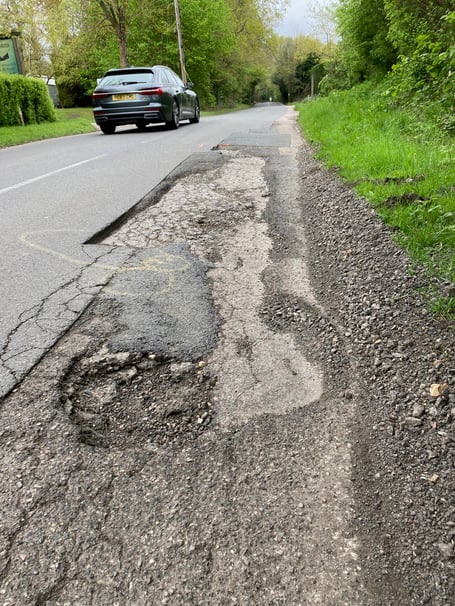IT IS a fine day... no rain, no wind, no dazzling sunshine. It is mid-morning, mid-week. The vehicle in front is swerving across the road. My goodness, look how wide he took that corner! Drunk? At this time of day? With work tomorrow? No. The driver is a local and he knows where the potholes are.
I did wonder why these pesky things are called potholes. Evidently, the term was not used to describe a hole in the road until about 1909. Before that, a pothole was a geological feature in glaciers and gravel beds. A pot being a deep hole, or even a mine.
Potholes as we know them are not as deep as that, thank goodness. It takes just two things to start a pothole forming, water and traffic.
The faster, and heavier the vehicles, the greater the likelihood of potholes forming. With frost getting into cracks in the road surface, the formation of a pothole is increased alarmingly.
According to the price comparison website Comparethemarket, which studied the Road Indicator Report of 2020-21, 35% of roads in the country are flagged as amber or red, signifying the need for maintenance within the next year.
The Asphalt Industry Alliance, in its annual statement as reported by The Daily Telegraph, documented that nearly 37,000 miles of road were in poor condition and had less than five years of life remaining without intervention. It estimated that more than £14billion is needed fix all of the potholes in England and Wales.
There is little to be done about the weather, unless one is considering under-road heating, which is possible but rather on the expensive side.
Surface thickness is crucial in that it has to be of sufficient depth to support traffic during freeze-thaw periods. Insufficient drainage will, of course, make matters worse.
As ever, joins are the weak spots. Cracks left unsealed around drains and inspection covers, and where the road has been dug up by one of the many utility companies which has permission to do so, do not help.
It is no surprise to see one utility digging up the road and, having made good, another utility comes along and does likewise. Any problems caused may be blamed on the other chap and, in both cases, the remedial work was deemed so urgent there was no time to check with other utilities.
Like a house requiring painting, the most important, but unseen, work is in the preparation.
With so many potholes requiring urgent treatment it is most likely that the repairs will come under the heading of “temporary”. We’ll come back and finish the job properly, honest we will!
But the list of potholes waiting to be done is so long that the temporary repair becomes a permanent repair. Except that it isn’t. It comes to pieces and causes even more trouble.
A stitch in time saves nine? That means a good, firm, stitch, not just the thread pulled through and knotted to hold the material together, but proper sewing which will last for a considerable time.
Could we do something? The singer Sir Rod Stewart did when, last year, fed up with council response, or non-response, he got some friends together and repaired his bit of road in Essex himself.
I read that Stoke-on-Trent council invested in a JCB Pothole Pro machine which has apparently fixed three years’ worth of potholes in four months, safely and efficiently.
Failing that, perhaps the guys laying the pathways around the Rive Ponds could be recruited?
The RAC refers to potholes as “a menace to all road users. They create a totally unnecessary road safety danger as well as costing motorists thousands of pounds in expensive repairs”.
For a look on the bright side there is the RAC Guide to the Great British Pothole. There these menaces have been graced with names, such as The Classic, The Alcatraz, The Slalom, The Alligator, The Sniper, The Canyon – and I looked at the illustrations and realised what diabolical things these are.
The Alcatraz, should you be wondering, is captioned: “There’s no escaping this one. A pothole, or cluster of potholes, that are extremely difficult to avoid due to their size, location or number. The damage one of these could cause to a vehicle may not be criminal, but it surely must come close. And the thought of someone on two wheels hitting one is beyond frightening.”
There is also The Groundhog: “You don’t have to go to Punxsutawney, Pennsylvania, to find one of these, you can find plenty right here in good old Blighty. Born of the “patch and dash” approach to road maintenance, this one recurs more often than Bill Murray’s day or a bad case of heartburn. If only they’d fixed it properly the first time round, there wouldn’t be so ‘many unhappy returns’.”
Those last lines have the problem in a nutshell. Or in a pothole?


.png?width=209&height=140&crop=209:145,smart&quality=75)


Comments
This article has no comments yet. Be the first to leave a comment.